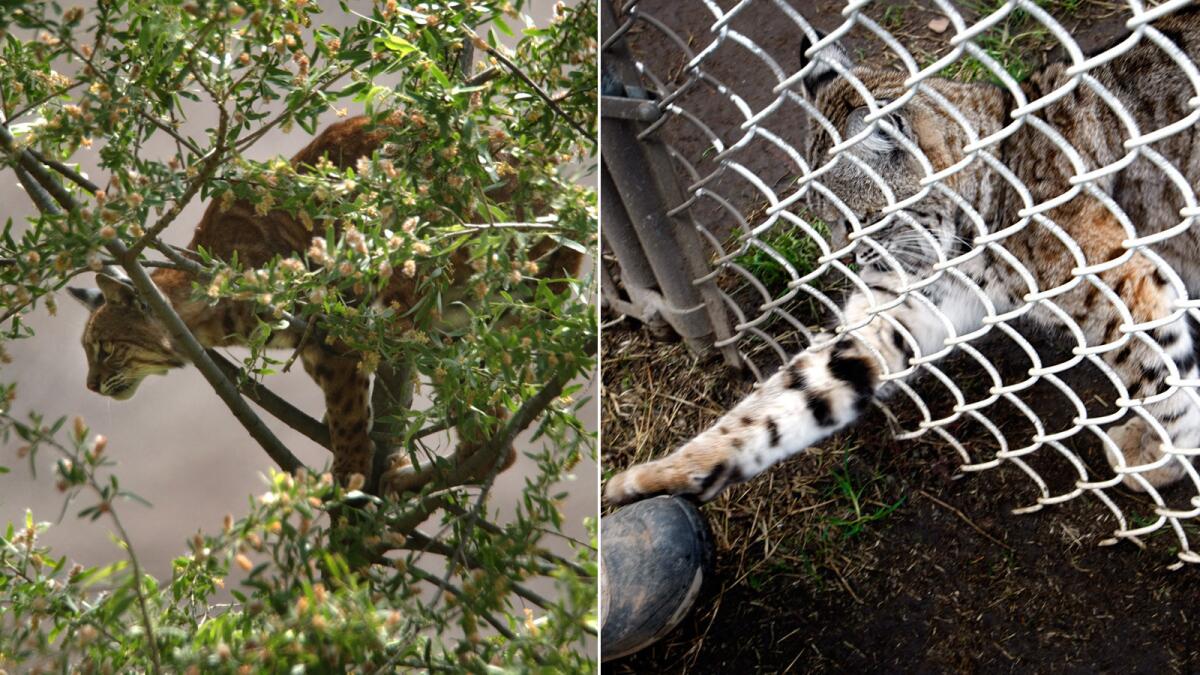California game commission to weigh in on proposed bobcat trapping ban

A treed bobcat in an Orange County Park, and one at a rescue facility.
- Share via
The fate of a vanishing California breed whose numbers have plummeted over the last three decades is now in the hands of the state Fish and Game commissioners. They are to decide this week whether commercial bobcat trappers can continue to operate in the state.
As California’s population has grown and sensibilities about nature and fauna have changed in recent decades, the number of commercial bobcat trappers has fallen to just 100 from 3,400 in 1982. Fish and Game will now decide whether this practice will survive.
On Wednesday, the five-member commission is expected to adopt one of two controversial options: a statewide ban on bobcat trapping, or a partial ban covering roughly half the state.
The options arose out of the Bobcat Protection Act of 2013, which directed the commission to prohibit bobcat trapping adjacent to national and state parks. It also says that commercial trapping programs, if allowed to continue anywhere in the state, must be self-funding.
The California Department of Fish and Wildlife, which enforces regulations adopted by the commission, has recommended a “zonal approach,” or partial ban. It would allow the state’s 200 licensed trappers — roughly half of whom specialize in bobcats — to harvest pelts in areas where high-value bobcat populations exist.
That proposal allows trapping to continue in hot spots that include Los Angeles, San Bernardino and Riverside counties, where 537 bobcats were taken in the 2013-14 season. Statewide, 1,300 bobcats were taken last season.
Animal rights activists say the practice is cruel. Trapped animals are strangled, shot or beaten to death, with care taken not to damage pelts before skinning them.
Activists also say that only a total ban can prevent trapping from disrupting genetic lineages of bobcats that travel along interconnected wildlife corridors stretching for miles over private and protected lands.
Trappers say that arguments about harming the bobcat population are uninformed. The California Trappers Assn. recently asked the commission to postpone action until after state wildlife authorities have a chance to conduct a comprehensive survey, the first in 36 years, to determine the size and health of the overall population.
“Without that information, we’ll be looking at implementation of a state law based on mere opinion,” association spokesman Hector Barajas said. The association wants both the full and partial bans taken off the table, Barajas said.
Trappers also say critics forget that trapping is a historic trade that requires detailed understanding of a prey’s diet, preferred terrain, tracks and hunting habits.
Mercer Lawing, who manufactures bobcat traps in Barstow, said, “We love those animals more than the people who are complaining about us trapping them do.” He added that he takes only adult male cats and turns loose females and kittens.
An adult bobcat stands up to about 23 inches high and can cover 25 to 30 miles of territory in a day. Using sharp claws and powerful legs, it preys on rabbits and makes a significant contribution to rodent control.
A premium pelt of heavily spotted white belly fur could bring a trapper more than $400 when sold in top dollar markets such as China, Russia and Greece.
Fish and Wildlife officials express reluctance to curtailing trapping.
“Our mission is to manage the state’s diverse species for their ecological values and for their use and enjoyment of the public,” said Jordan Traverso, a spokeswoman for the department. For instance, he said, the department favors hunting.
Opponents express doubts that trappers can pay enough money to cover the state’s cost of regulating the industry. The Fish and Wildlife Department estimates the cost at $605,000 in its first year.
Under existing regulations, trappers pay $113.75 for a license. The new law, which the department wants in place before trapping season begins in November, would require trappers to pay an annual validation fee of $1,325 in addition to a $35 shipping fee tag per animal.
The department anticipates that the increased fees will reduce the number of licensed trappers about 20%. Critics say it would be all but impossible for the remaining trappers, numbering less than 100, to pay enough to support trapping programs.
Brendan Cummings, senior counsel for the Center for Biological Diversity, argued that if a partial ban is adopted, taxpayers will end up subsidizing trappers because the state will not collect enough from them to offset the costs of regulating the industry.
The controversy over bobcat trapping began in 2013, when a resident of Joshua Tree, Tom O’Key, found a wire cage chained to a bush on his property near the northern edge of Joshua Tree National Park.
O’Key alerted others in the community, which responded with petition drives, social media campaigns and telephone calls to lawmakers. The 45 bobcats taken by trappers that year were top predators in the region and part of the draw for tourists to the national park. Some were so well-known in the adjacent community of Joshua Tree that they had nicknames — Big Gray, Leroy, Tomboy.
Assemblyman Richard Hershel Bloom (D-Santa Monica) introduced the bobcat law in response to the outrage.
To date, there have been more than 25,000 registered comments in support of the statewide ban, and a dozen letters in favor of trapping zones.
Twitter: @LouisSahagun
More to Read
Sign up for Essential California
The most important California stories and recommendations in your inbox every morning.
You may occasionally receive promotional content from the Los Angeles Times.











